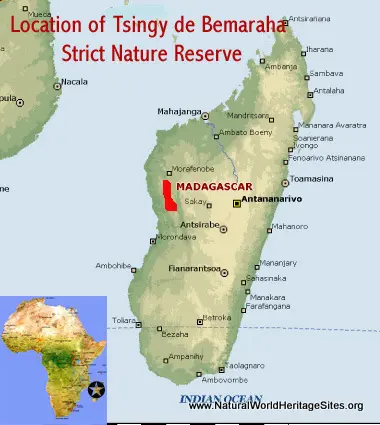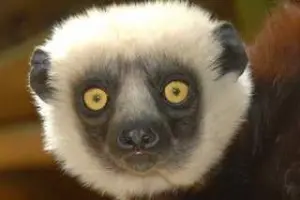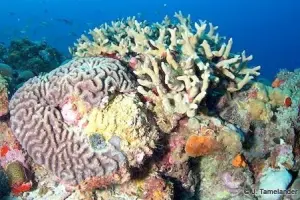EXPLORE MADAGASCAR’S TSINGY DE BEMARAHA STRICT NATURE RESERVE with this slideshow, check the location map and get all the facts and information below.
For slideshow description see right or scroll down (mobile). Click to view slideshow
Values: Tsingy de Bemaraha Reserve is located in the drier western side of Madagascar and supports a quite distinct fauna and flora in a dramatic karst landscape. The limestone plateau has been carved into an impressive forest of pinnacles (tsingys) and caves, with deep gorges filled with forest. The undisturbed forests are the habitat of many rare and endangered species with highly restricted ranges including lemurs, chameleons, and other taxa.
A comprehensive review of the world heritage values of the site is provided below, together with details of the area’s conservation status and the threats it faces.
REVIEW OF WORLD HERITAGE VALUES: According to IUCN’s Conservation Outlook Assessment (2014), the specific attributes which qualify Tsingy de Bemaraha Strict Nature Reserve for world heritage status can be summarised as follows:
Unique and spectacular geomorphological features. The 250 km long Bemaraha Plateau is a unique, spectacular landscape of outstanding beauty. Its most prominent feature is an extensive ‘forest’ of sharp limestone pinnacles, up to 100 metres high, with networks of deep crevasses, underground rivers and caves below.
Rich endemic flora. The vegetation is classified as ‘western dry forest’, one of the most threatened biomes in Madagascar. The flora of the dry forest is typically deciduous, with dominant trees of the genera Dalbergia, Commiphora and Hildegardia. Meanwhile, the vegetation on the exposed rocks comprises a xerophytic scrub containing succulents, and the canyons enjoy moister conditions which supports a dense sub-humid forest. At least 457 plant species representing 81 families have been recorded. Although the number of endemic plants within the reserve is unknown, 84% of Madagascar’s vascular plants are endemic to the island. Most of the reserve’s plants are found only in the drier parts of Madagascar and therefore likely to have very limited worldwide distributions. Internationally-recognised threatened species of tree include the ‘Endangered’ Khaya madagascariensis, Phylloxylon perrieri, and Dalbergia humbertii, as well as the ‘Vulnerable’ Dalbergia baronii and Delonix regia.
Rare and endemic mammals. At least 42 species of mammal have been recorded, of which 35 are endemic to Madagascar. Eleven species of lemur occur, including the ‘Vulnerable’ Decken’s sifaka and the recently described, locally endemic Bemaraha woolly lemur (classified as ‘Endangered’). Eleven species of small mammal are known from the reserve, including three that are locally endemic to a small area of north-western Madagascar: Grandidier’s shrew tenrec (described in 2009), Tsingy tuft-tailed rat (described in 2001) and the ‘Endangered’ lowland red-forest rat. Two species of the endemic Malagasy civet and mongoose family (Eupleridae) have been recorded, as well as 18 species of bat.
Rare and endemic birds. Although the number of bird species recorded in the reserve is relatively small (94 species), a remarkably high proportion of them are found only in Madagascar, including species of the endemic family of Malagasy warblers (Bernieridae), the near endemic families of vangas (Vangidae) and the cuckoo roller (Leptosomatidae), as well as the endemic couas (subfamily Couinae) and asities (subfamily Philepittinae). Threatened species include the ‘Critically Endangered’ Madagascan fish eagle; the ‘Endangered’ Malagasy pond heron, Madagascar heron, Madagascar teal and Madagascar grebe (all of which are occasional visitors to the Manambolo river in the south of the reserve) and the ‘Vulnerable’ Malagasy harrier. Madagascar’s newest bird species, the rail Mentocrex beankaensis, was described in 2011 and is only known from the Bemaraha and Beanka massifs.
Rare and endemic reptiles and amphibians. Bemaraha supports an exceptionally rich fauna of reptiles and amphibians, many of which are threatened. At least63 reptile species have been recorded, of which 58 are endemic to Madagascar and 17 (27%) appear to be endemic to the Bemaraha massif. Nineteen species of amphibian are also known, representing the highest total for any site in the dry regions of Madagascar. Six of these species (some not yet described) appear to be endemic to Bemaraha. Threatened species of reptile include the ‘Critically Endangered’ Madagascar big-headed turtle; the ‘Vulnerable’ big-headed gecko, leaf-tailed gecko, dwarf chameleon, Ground Gecko (Paroedura tanjaka), Nicosia’s chameleon and the arboreal snake, Phisalixella variabilis; as well as four species classified as ‘Vulnerable’ Amphiglossus splendidus, Madascincus intermedius, Uroplatus ebenaui and Lycodryas citrinus. New species are being ‘discovered’ quite frequently, while others await formal scientific description.
CONSERVATION STATUS AND PROSPECTS: The outlook for the conservation of the Tsingy de Bemaraha world heritage site is good. It covers two suitably-managed, legally recognised protected areas and its impenetrable nature makes it largely immune from human activities and man-made threats. There is a limited amount of logging, subsistence hunting, agricultural encroachment and fire around the periphery of the reserve, but no commercial extraction is taking place (apart from limited trade in reptiles).
MANAGEMENT EFFECTIVENESS: The majority of the property is naturally protected by its impenetrable nature. It is legally protected and enjoys the support of local communities and regional authorities. An appropriate management system exists (although the management plan was out of date in 2014).
REVIEW OF CONSERVATION ISSUES AND THREATS: The following issues represent specific threats to the ecology, conservation and values of Tsingy de Bemaraha world heritage site.
Subsistence hunting. A limited amount of subsistence hunting takes place, particularly in the vicinity of villages adjacent to the reserve, targeting various species of lemur. The critically endangered Madagascar big-headed turtle is hunted in the Manambolo River. Overall, hunting pressure is probably not high enough to have a significant impact on the populations of target species.
Cattle Grazing. Cattle are brought into the more accessible parts of the reserve for grazing and may affect natural regeneration of forest in some areas.
Incidence of Fire. Fires are set in June-October, (before the seasonal rains), to stimulate the growth of new grass for cattle grazing, and allow easy access for local people making subsistence use of minor forest produce. This may affect regeneration of some vulnerable (forest) species of plants, and kill animals caught up in the fires, especially slow-moving reptiles and amphibians.
Agricultural encroachment. There is some indication of limited, highly localised agricultural encroachment practising slash-and-burn cultivation. This is not thought to be widespread, but may become more widespread as land-use pressures across Madagascar continue to increase.
Exploitation of minor forest produce. There is considerable pressure from local communities for honey and certain plant tubers collected from the reserve. The impact of this limited by the inaccessible nature of much of the area.
Invasive Alien Species. No problems related to invasive alien species are known within the reserve, although the introduced tree Ziziphus sp. has become established elsewhere in the region, where it forms thick, single-species stands replacing the natural vegetation. Fortunately it does not appear to invade intact forest, and has not yet been recorded in the reserve.
International trade in reptiles as pets. Some reptiles are collected for the international pet trade, particularly specimens of the remarkable leaf-tailed gecko (Uroplatus henkeli) and the highly sought-after dwarf chameleon (Brookesia perarmata). The extent of collection from the reserve is not known, but has probably reduced in recent years, especially since the dwarf chameleon was listed under Appendix I of the Convention on International Trade in Endangered Species (CITES) in 2002.
Tourism. The number of visitors is limited by the reserve’s difficult access, and their impact is highly localised and superficial.
Settlement by immigrants. While the indigenous local communities tend to support conservation of the Tsingy (partly because it holds important cultural heritage values for them), the region is becoming increasingly settled by immigrants from other parts of Madagascar who don’t share those values and may be more inclined to over-exploit natural products from the reserve and its vicinity.
Climate change. The potential impacts of climate change are unknown, but it clearly represents a significant long-term threat to the area’s species and ecology. The Bemaraha Plateau has served as a ‘refugium’ for plants and animals during previous periods of climate change and may be more ecologically resilient than less diverse parts of western Madagascar’s dry forest zone.
Oil and gas exploitation. The reserve is significantly threatened by the occurrence of known natural gas deposits held under a concession by Madagascar Oil. However, no exploration or exploitation from the reserve and a 2.5 km ‘protective zone’ around it is being carried out at present. In addition, there are large tar sand resources elsewhere in the region, and their exploitation may have a significant impact on the reserve in future, transforming the regional economy and increasing immigration into the area. In an earlier era of oil exploration, American oil prospectors blasted a seismographic trail through the Tsingy de Bemeraha in 1984, facilitating access to the interior of the reserve by hunters.
Links:
Google Earth
UNEP-WCMC Site Description
IUCN Conservation Outlook
UNESCO Offical Website
Birdlife IBA
Slideshow description
The slideshow provides a comprehensive overview of Madagascar’s Tsingy de Bemaraha Strict Nature Reserve world heritage site, showing the area’s spectacular karst landscapes, wildlife habitats, endemic plants and animals, lemurs, chameleons and other threatened species, conservation management issues, local community livelihoods and some of the visitor facilities and typical experiences.
Factfile
Website categories: Islands; Caves & Karst
Area: 1,520 km2
Inscribed: 1990
Criteria:
- (vii) aesthetic;
- (x) biodiversity





